Southern Cross University: Case Study on Tokyo Tourism, MKT01906
VerifiedAdded on 2022/08/23
|13
|3554
|14
Case Study
AI Summary
This case study examines the international tourism system in Tokyo, Japan. The report provides an overview of Tokyo's historical development as a major tourist destination, highlighting key attractions and the evolution of tourism. It analyzes international tourist visitation patterns, supported by statistical data, and explores the factors contributing to Tokyo's destination attractiveness, including cultural, technological, and architectural marvels. The study also delves into the positive and negative impacts of tourism on the host community, identifying key issues such as over-tourism and its effects on infrastructure and resources. Furthermore, the case study provides recommendations for addressing these challenges, including strategies for sustainable tourism development and the promotion of ecotourism, aiming to enhance the tourist experience while preserving the city's cultural and environmental integrity. The report also includes analysis of tourism policies, and the impact of events like the Olympics.
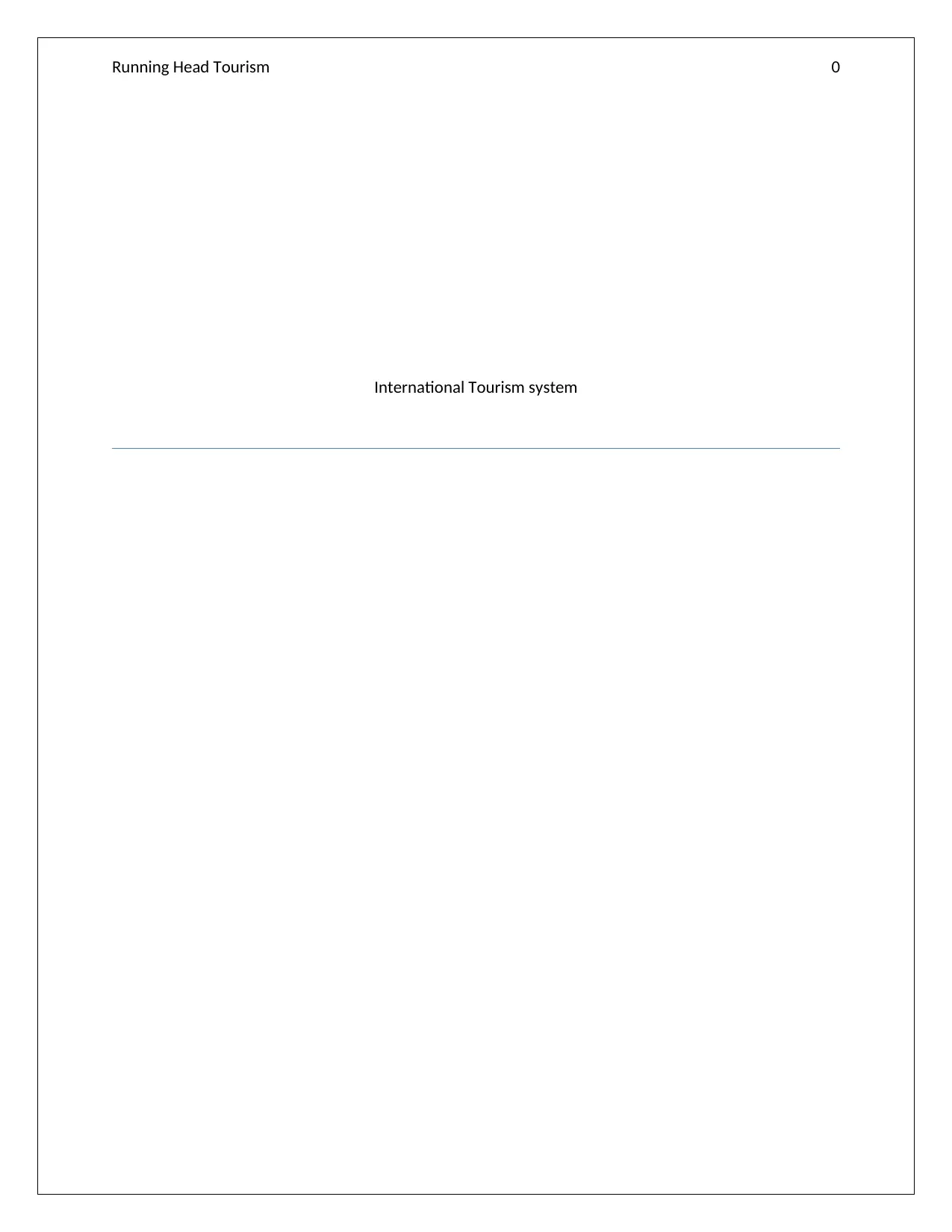
Running Head Tourism 0
International Tourism system
International Tourism system
Paraphrase This Document
Need a fresh take? Get an instant paraphrase of this document with our AI Paraphraser
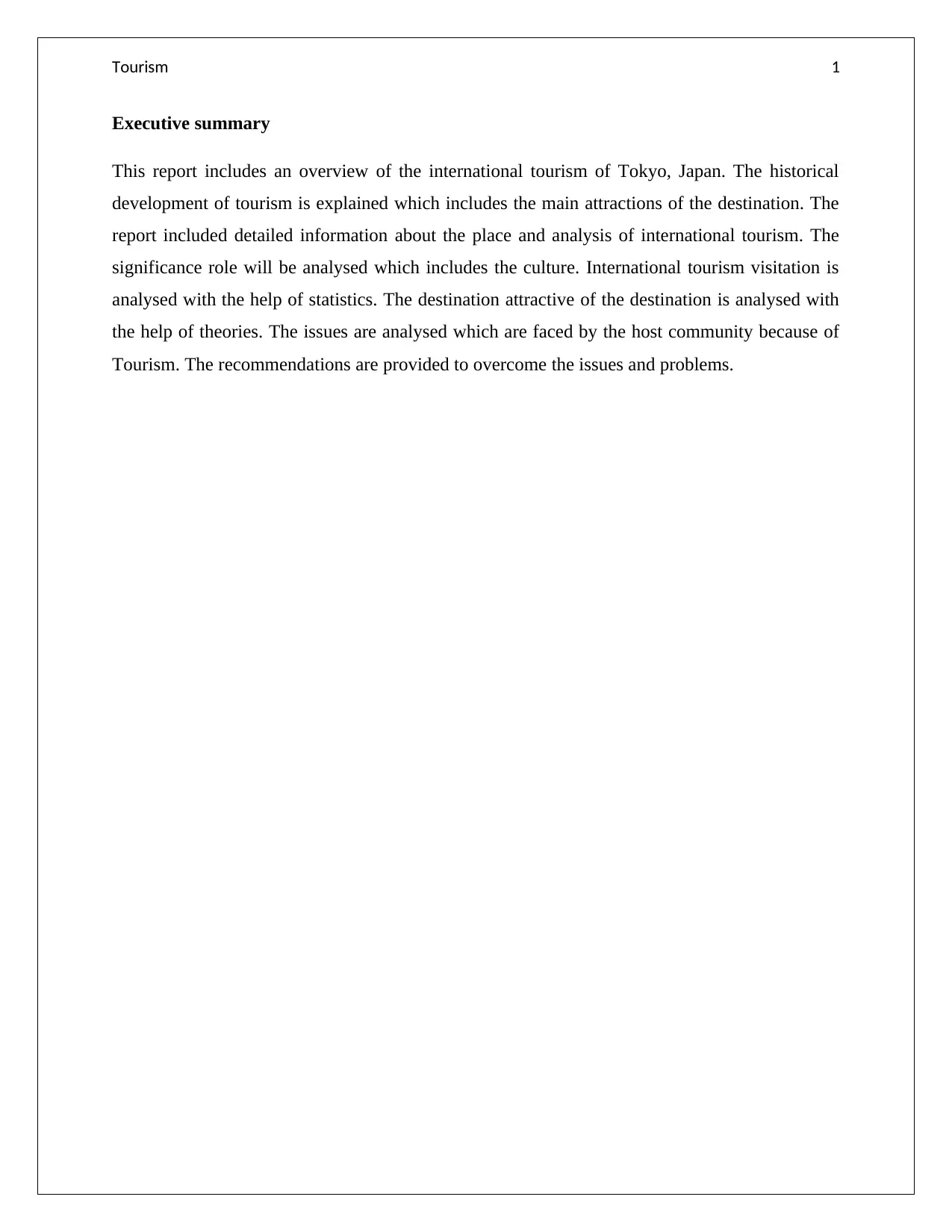
Tourism 1
Executive summary
This report includes an overview of the international tourism of Tokyo, Japan. The historical
development of tourism is explained which includes the main attractions of the destination. The
report included detailed information about the place and analysis of international tourism. The
significance role will be analysed which includes the culture. International tourism visitation is
analysed with the help of statistics. The destination attractive of the destination is analysed with
the help of theories. The issues are analysed which are faced by the host community because of
Tourism. The recommendations are provided to overcome the issues and problems.
Executive summary
This report includes an overview of the international tourism of Tokyo, Japan. The historical
development of tourism is explained which includes the main attractions of the destination. The
report included detailed information about the place and analysis of international tourism. The
significance role will be analysed which includes the culture. International tourism visitation is
analysed with the help of statistics. The destination attractive of the destination is analysed with
the help of theories. The issues are analysed which are faced by the host community because of
Tourism. The recommendations are provided to overcome the issues and problems.
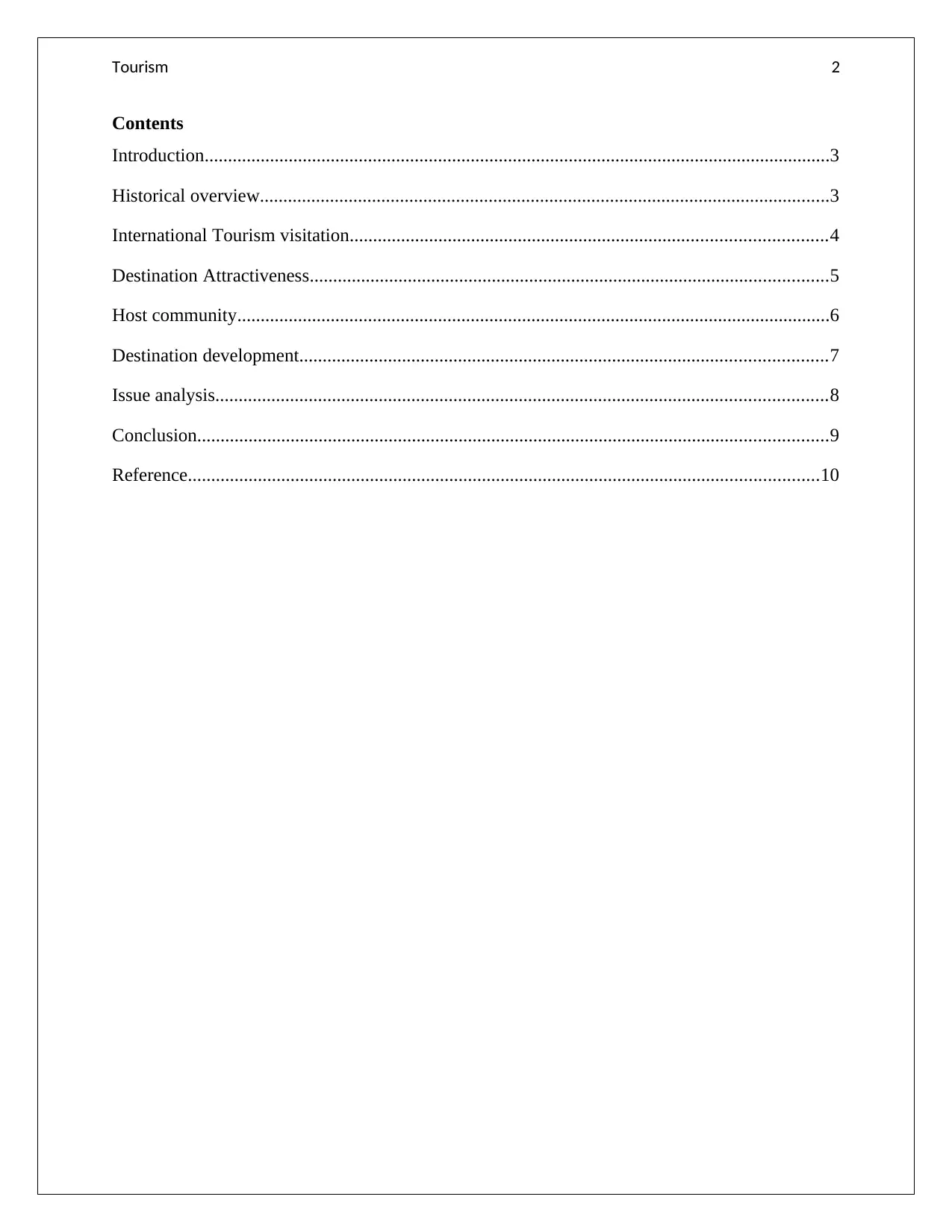
Tourism 2
Contents
Introduction......................................................................................................................................3
Historical overview..........................................................................................................................3
International Tourism visitation......................................................................................................4
Destination Attractiveness...............................................................................................................5
Host community...............................................................................................................................6
Destination development.................................................................................................................7
Issue analysis...................................................................................................................................8
Conclusion.......................................................................................................................................9
Reference.......................................................................................................................................10
Contents
Introduction......................................................................................................................................3
Historical overview..........................................................................................................................3
International Tourism visitation......................................................................................................4
Destination Attractiveness...............................................................................................................5
Host community...............................................................................................................................6
Destination development.................................................................................................................7
Issue analysis...................................................................................................................................8
Conclusion.......................................................................................................................................9
Reference.......................................................................................................................................10
⊘ This is a preview!⊘
Do you want full access?
Subscribe today to unlock all pages.

Trusted by 1+ million students worldwide
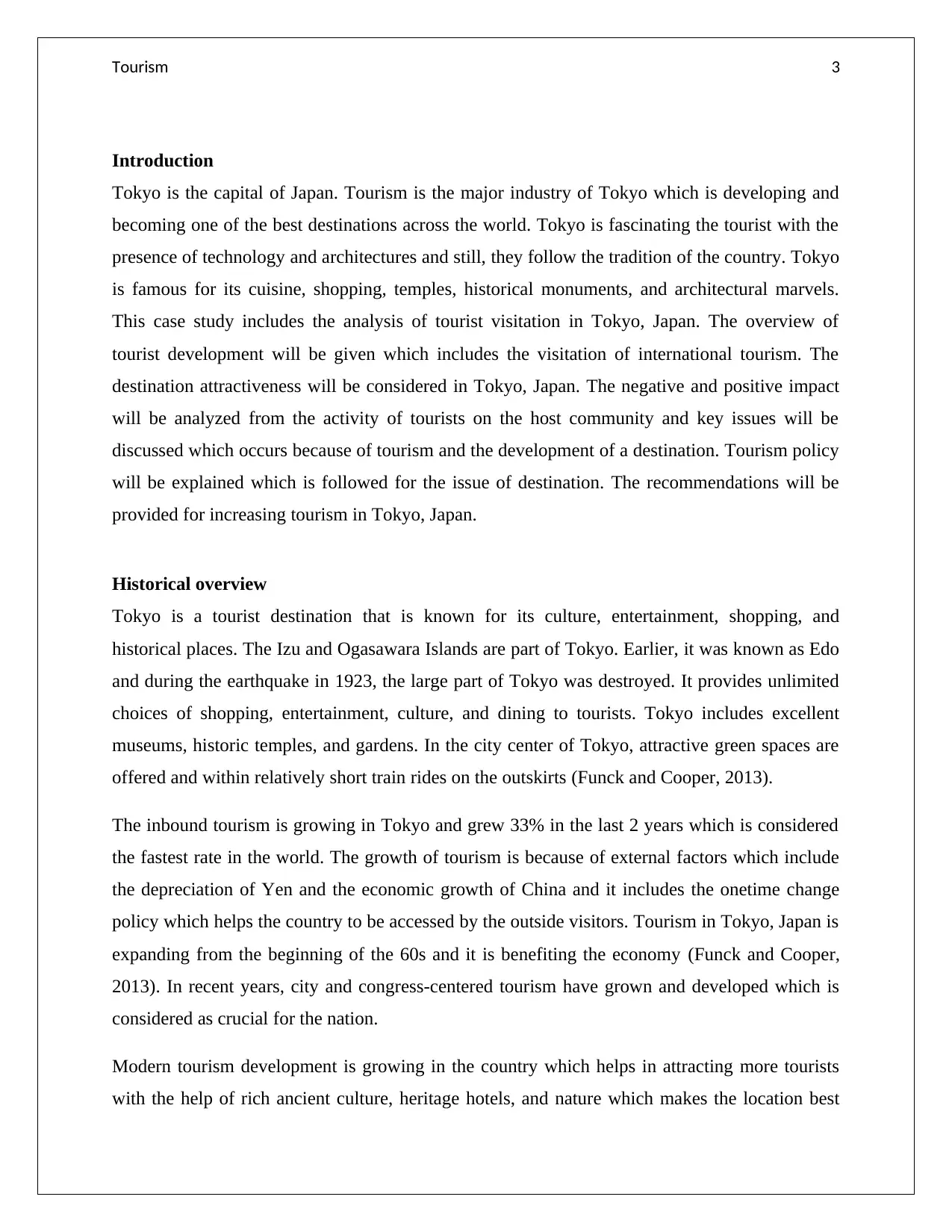
Tourism 3
Introduction
Tokyo is the capital of Japan. Tourism is the major industry of Tokyo which is developing and
becoming one of the best destinations across the world. Tokyo is fascinating the tourist with the
presence of technology and architectures and still, they follow the tradition of the country. Tokyo
is famous for its cuisine, shopping, temples, historical monuments, and architectural marvels.
This case study includes the analysis of tourist visitation in Tokyo, Japan. The overview of
tourist development will be given which includes the visitation of international tourism. The
destination attractiveness will be considered in Tokyo, Japan. The negative and positive impact
will be analyzed from the activity of tourists on the host community and key issues will be
discussed which occurs because of tourism and the development of a destination. Tourism policy
will be explained which is followed for the issue of destination. The recommendations will be
provided for increasing tourism in Tokyo, Japan.
Historical overview
Tokyo is a tourist destination that is known for its culture, entertainment, shopping, and
historical places. The Izu and Ogasawara Islands are part of Tokyo. Earlier, it was known as Edo
and during the earthquake in 1923, the large part of Tokyo was destroyed. It provides unlimited
choices of shopping, entertainment, culture, and dining to tourists. Tokyo includes excellent
museums, historic temples, and gardens. In the city center of Tokyo, attractive green spaces are
offered and within relatively short train rides on the outskirts (Funck and Cooper, 2013).
The inbound tourism is growing in Tokyo and grew 33% in the last 2 years which is considered
the fastest rate in the world. The growth of tourism is because of external factors which include
the depreciation of Yen and the economic growth of China and it includes the onetime change
policy which helps the country to be accessed by the outside visitors. Tourism in Tokyo, Japan is
expanding from the beginning of the 60s and it is benefiting the economy (Funck and Cooper,
2013). In recent years, city and congress-centered tourism have grown and developed which is
considered as crucial for the nation.
Modern tourism development is growing in the country which helps in attracting more tourists
with the help of rich ancient culture, heritage hotels, and nature which makes the location best
Introduction
Tokyo is the capital of Japan. Tourism is the major industry of Tokyo which is developing and
becoming one of the best destinations across the world. Tokyo is fascinating the tourist with the
presence of technology and architectures and still, they follow the tradition of the country. Tokyo
is famous for its cuisine, shopping, temples, historical monuments, and architectural marvels.
This case study includes the analysis of tourist visitation in Tokyo, Japan. The overview of
tourist development will be given which includes the visitation of international tourism. The
destination attractiveness will be considered in Tokyo, Japan. The negative and positive impact
will be analyzed from the activity of tourists on the host community and key issues will be
discussed which occurs because of tourism and the development of a destination. Tourism policy
will be explained which is followed for the issue of destination. The recommendations will be
provided for increasing tourism in Tokyo, Japan.
Historical overview
Tokyo is a tourist destination that is known for its culture, entertainment, shopping, and
historical places. The Izu and Ogasawara Islands are part of Tokyo. Earlier, it was known as Edo
and during the earthquake in 1923, the large part of Tokyo was destroyed. It provides unlimited
choices of shopping, entertainment, culture, and dining to tourists. Tokyo includes excellent
museums, historic temples, and gardens. In the city center of Tokyo, attractive green spaces are
offered and within relatively short train rides on the outskirts (Funck and Cooper, 2013).
The inbound tourism is growing in Tokyo and grew 33% in the last 2 years which is considered
the fastest rate in the world. The growth of tourism is because of external factors which include
the depreciation of Yen and the economic growth of China and it includes the onetime change
policy which helps the country to be accessed by the outside visitors. Tourism in Tokyo, Japan is
expanding from the beginning of the 60s and it is benefiting the economy (Funck and Cooper,
2013). In recent years, city and congress-centered tourism have grown and developed which is
considered as crucial for the nation.
Modern tourism development is growing in the country which helps in attracting more tourists
with the help of rich ancient culture, heritage hotels, and nature which makes the location best
Paraphrase This Document
Need a fresh take? Get an instant paraphrase of this document with our AI Paraphraser
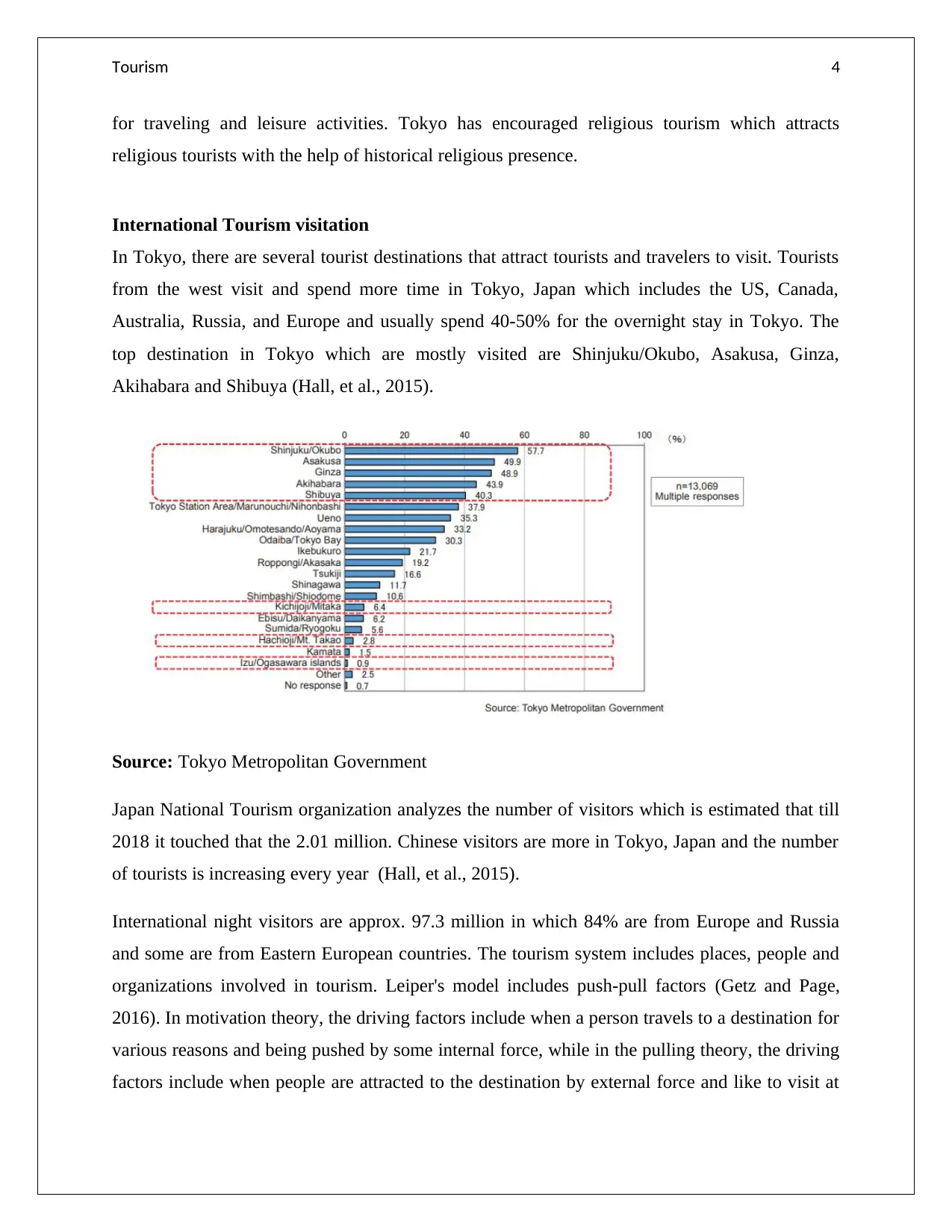
Tourism 4
for traveling and leisure activities. Tokyo has encouraged religious tourism which attracts
religious tourists with the help of historical religious presence.
International Tourism visitation
In Tokyo, there are several tourist destinations that attract tourists and travelers to visit. Tourists
from the west visit and spend more time in Tokyo, Japan which includes the US, Canada,
Australia, Russia, and Europe and usually spend 40-50% for the overnight stay in Tokyo. The
top destination in Tokyo which are mostly visited are Shinjuku/Okubo, Asakusa, Ginza,
Akihabara and Shibuya (Hall, et al., 2015).
Source: Tokyo Metropolitan Government
Japan National Tourism organization analyzes the number of visitors which is estimated that till
2018 it touched that the 2.01 million. Chinese visitors are more in Tokyo, Japan and the number
of tourists is increasing every year (Hall, et al., 2015).
International night visitors are approx. 97.3 million in which 84% are from Europe and Russia
and some are from Eastern European countries. The tourism system includes places, people and
organizations involved in tourism. Leiper's model includes push-pull factors (Getz and Page,
2016). In motivation theory, the driving factors include when a person travels to a destination for
various reasons and being pushed by some internal force, while in the pulling theory, the driving
factors include when people are attracted to the destination by external force and like to visit at
for traveling and leisure activities. Tokyo has encouraged religious tourism which attracts
religious tourists with the help of historical religious presence.
International Tourism visitation
In Tokyo, there are several tourist destinations that attract tourists and travelers to visit. Tourists
from the west visit and spend more time in Tokyo, Japan which includes the US, Canada,
Australia, Russia, and Europe and usually spend 40-50% for the overnight stay in Tokyo. The
top destination in Tokyo which are mostly visited are Shinjuku/Okubo, Asakusa, Ginza,
Akihabara and Shibuya (Hall, et al., 2015).
Source: Tokyo Metropolitan Government
Japan National Tourism organization analyzes the number of visitors which is estimated that till
2018 it touched that the 2.01 million. Chinese visitors are more in Tokyo, Japan and the number
of tourists is increasing every year (Hall, et al., 2015).
International night visitors are approx. 97.3 million in which 84% are from Europe and Russia
and some are from Eastern European countries. The tourism system includes places, people and
organizations involved in tourism. Leiper's model includes push-pull factors (Getz and Page,
2016). In motivation theory, the driving factors include when a person travels to a destination for
various reasons and being pushed by some internal force, while in the pulling theory, the driving
factors include when people are attracted to the destination by external force and like to visit at
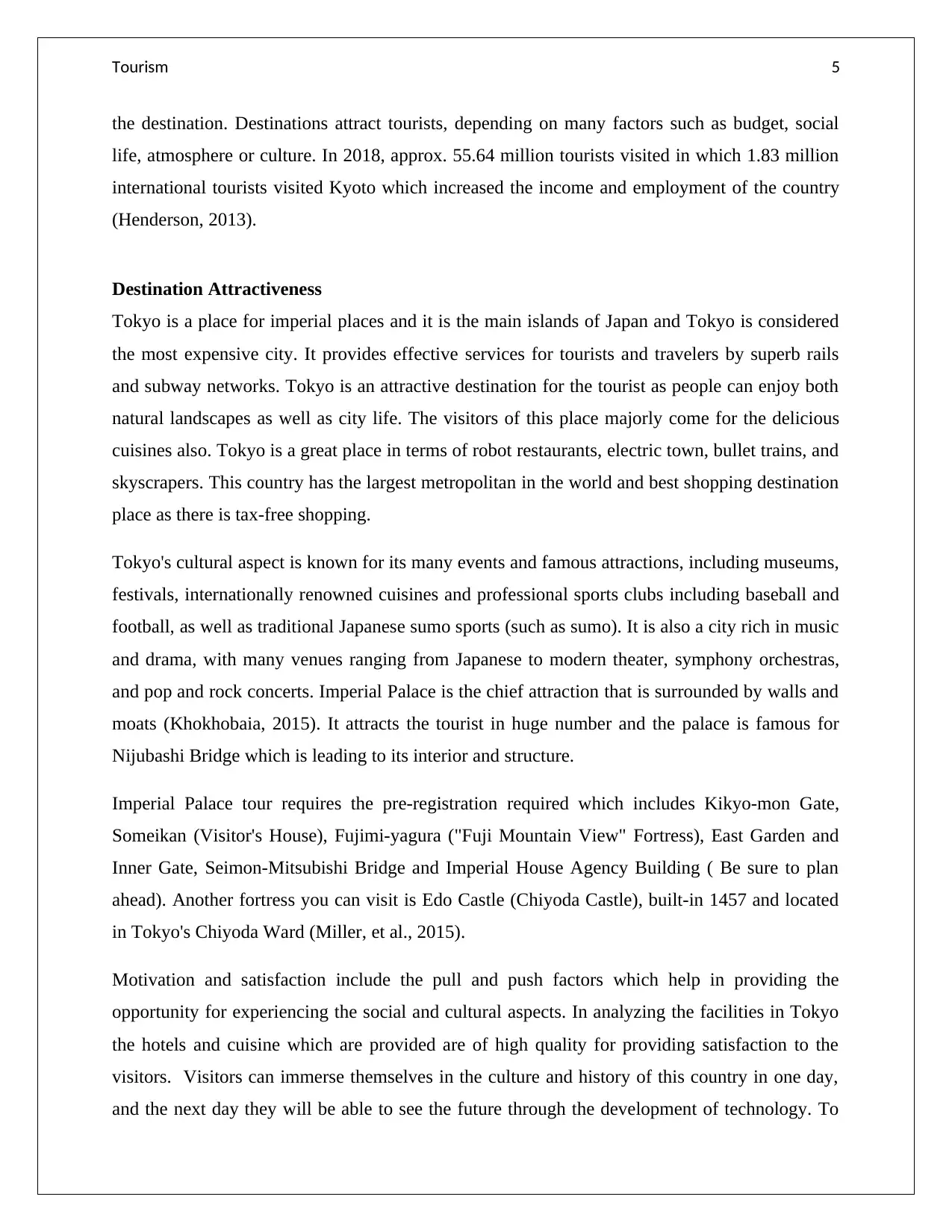
Tourism 5
the destination. Destinations attract tourists, depending on many factors such as budget, social
life, atmosphere or culture. In 2018, approx. 55.64 million tourists visited in which 1.83 million
international tourists visited Kyoto which increased the income and employment of the country
(Henderson, 2013).
Destination Attractiveness
Tokyo is a place for imperial places and it is the main islands of Japan and Tokyo is considered
the most expensive city. It provides effective services for tourists and travelers by superb rails
and subway networks. Tokyo is an attractive destination for the tourist as people can enjoy both
natural landscapes as well as city life. The visitors of this place majorly come for the delicious
cuisines also. Tokyo is a great place in terms of robot restaurants, electric town, bullet trains, and
skyscrapers. This country has the largest metropolitan in the world and best shopping destination
place as there is tax-free shopping.
Tokyo's cultural aspect is known for its many events and famous attractions, including museums,
festivals, internationally renowned cuisines and professional sports clubs including baseball and
football, as well as traditional Japanese sumo sports (such as sumo). It is also a city rich in music
and drama, with many venues ranging from Japanese to modern theater, symphony orchestras,
and pop and rock concerts. Imperial Palace is the chief attraction that is surrounded by walls and
moats (Khokhobaia, 2015). It attracts the tourist in huge number and the palace is famous for
Nijubashi Bridge which is leading to its interior and structure.
Imperial Palace tour requires the pre-registration required which includes Kikyo-mon Gate,
Someikan (Visitor's House), Fujimi-yagura ("Fuji Mountain View" Fortress), East Garden and
Inner Gate, Seimon-Mitsubishi Bridge and Imperial House Agency Building ( Be sure to plan
ahead). Another fortress you can visit is Edo Castle (Chiyoda Castle), built-in 1457 and located
in Tokyo's Chiyoda Ward (Miller, et al., 2015).
Motivation and satisfaction include the pull and push factors which help in providing the
opportunity for experiencing the social and cultural aspects. In analyzing the facilities in Tokyo
the hotels and cuisine which are provided are of high quality for providing satisfaction to the
visitors. Visitors can immerse themselves in the culture and history of this country in one day,
and the next day they will be able to see the future through the development of technology. To
the destination. Destinations attract tourists, depending on many factors such as budget, social
life, atmosphere or culture. In 2018, approx. 55.64 million tourists visited in which 1.83 million
international tourists visited Kyoto which increased the income and employment of the country
(Henderson, 2013).
Destination Attractiveness
Tokyo is a place for imperial places and it is the main islands of Japan and Tokyo is considered
the most expensive city. It provides effective services for tourists and travelers by superb rails
and subway networks. Tokyo is an attractive destination for the tourist as people can enjoy both
natural landscapes as well as city life. The visitors of this place majorly come for the delicious
cuisines also. Tokyo is a great place in terms of robot restaurants, electric town, bullet trains, and
skyscrapers. This country has the largest metropolitan in the world and best shopping destination
place as there is tax-free shopping.
Tokyo's cultural aspect is known for its many events and famous attractions, including museums,
festivals, internationally renowned cuisines and professional sports clubs including baseball and
football, as well as traditional Japanese sumo sports (such as sumo). It is also a city rich in music
and drama, with many venues ranging from Japanese to modern theater, symphony orchestras,
and pop and rock concerts. Imperial Palace is the chief attraction that is surrounded by walls and
moats (Khokhobaia, 2015). It attracts the tourist in huge number and the palace is famous for
Nijubashi Bridge which is leading to its interior and structure.
Imperial Palace tour requires the pre-registration required which includes Kikyo-mon Gate,
Someikan (Visitor's House), Fujimi-yagura ("Fuji Mountain View" Fortress), East Garden and
Inner Gate, Seimon-Mitsubishi Bridge and Imperial House Agency Building ( Be sure to plan
ahead). Another fortress you can visit is Edo Castle (Chiyoda Castle), built-in 1457 and located
in Tokyo's Chiyoda Ward (Miller, et al., 2015).
Motivation and satisfaction include the pull and push factors which help in providing the
opportunity for experiencing the social and cultural aspects. In analyzing the facilities in Tokyo
the hotels and cuisine which are provided are of high quality for providing satisfaction to the
visitors. Visitors can immerse themselves in the culture and history of this country in one day,
and the next day they will be able to see the future through the development of technology. To
⊘ This is a preview!⊘
Do you want full access?
Subscribe today to unlock all pages.

Trusted by 1+ million students worldwide
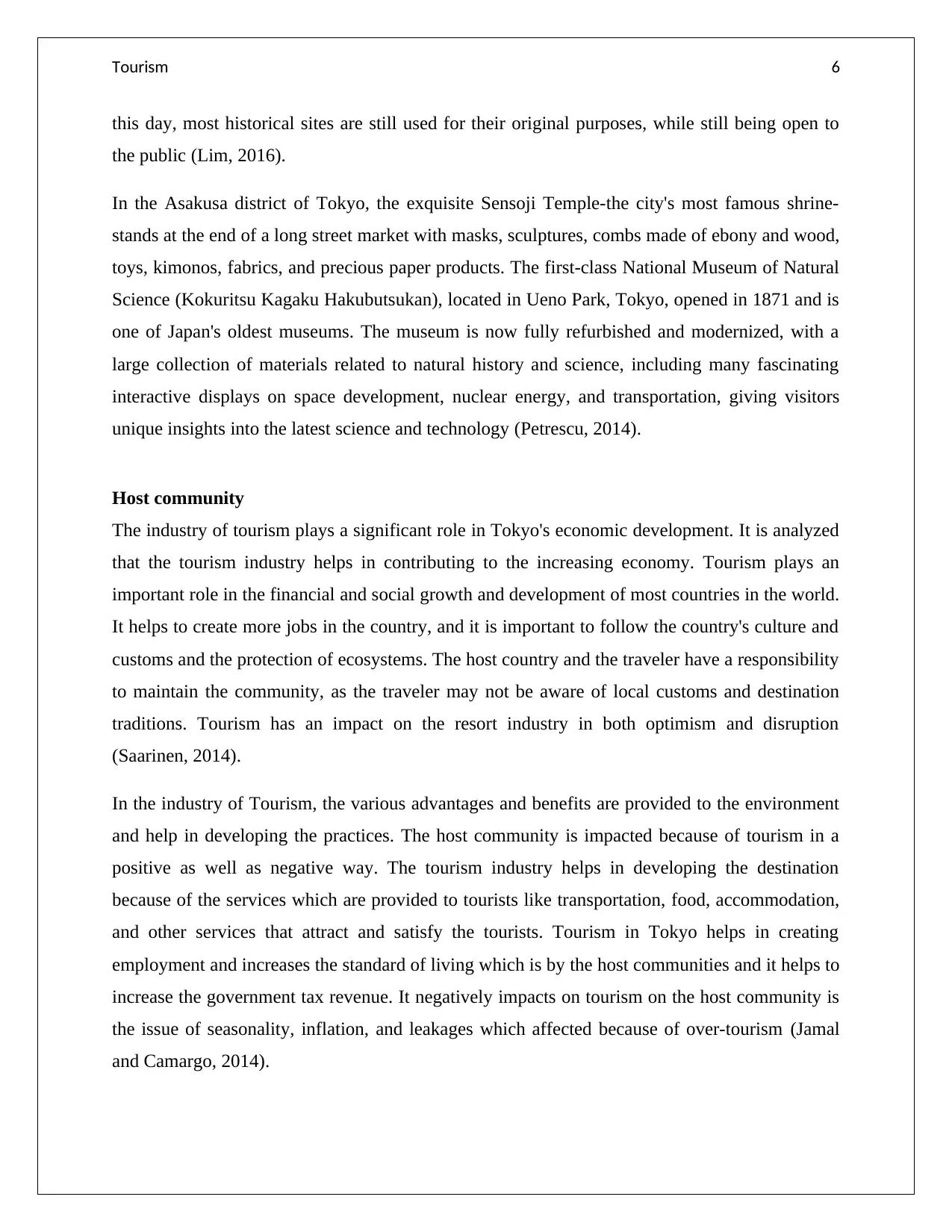
Tourism 6
this day, most historical sites are still used for their original purposes, while still being open to
the public (Lim, 2016).
In the Asakusa district of Tokyo, the exquisite Sensoji Temple-the city's most famous shrine-
stands at the end of a long street market with masks, sculptures, combs made of ebony and wood,
toys, kimonos, fabrics, and precious paper products. The first-class National Museum of Natural
Science (Kokuritsu Kagaku Hakubutsukan), located in Ueno Park, Tokyo, opened in 1871 and is
one of Japan's oldest museums. The museum is now fully refurbished and modernized, with a
large collection of materials related to natural history and science, including many fascinating
interactive displays on space development, nuclear energy, and transportation, giving visitors
unique insights into the latest science and technology (Petrescu, 2014).
Host community
The industry of tourism plays a significant role in Tokyo's economic development. It is analyzed
that the tourism industry helps in contributing to the increasing economy. Tourism plays an
important role in the financial and social growth and development of most countries in the world.
It helps to create more jobs in the country, and it is important to follow the country's culture and
customs and the protection of ecosystems. The host country and the traveler have a responsibility
to maintain the community, as the traveler may not be aware of local customs and destination
traditions. Tourism has an impact on the resort industry in both optimism and disruption
(Saarinen, 2014).
In the industry of Tourism, the various advantages and benefits are provided to the environment
and help in developing the practices. The host community is impacted because of tourism in a
positive as well as negative way. The tourism industry helps in developing the destination
because of the services which are provided to tourists like transportation, food, accommodation,
and other services that attract and satisfy the tourists. Tourism in Tokyo helps in creating
employment and increases the standard of living which is by the host communities and it helps to
increase the government tax revenue. It negatively impacts on tourism on the host community is
the issue of seasonality, inflation, and leakages which affected because of over-tourism (Jamal
and Camargo, 2014).
this day, most historical sites are still used for their original purposes, while still being open to
the public (Lim, 2016).
In the Asakusa district of Tokyo, the exquisite Sensoji Temple-the city's most famous shrine-
stands at the end of a long street market with masks, sculptures, combs made of ebony and wood,
toys, kimonos, fabrics, and precious paper products. The first-class National Museum of Natural
Science (Kokuritsu Kagaku Hakubutsukan), located in Ueno Park, Tokyo, opened in 1871 and is
one of Japan's oldest museums. The museum is now fully refurbished and modernized, with a
large collection of materials related to natural history and science, including many fascinating
interactive displays on space development, nuclear energy, and transportation, giving visitors
unique insights into the latest science and technology (Petrescu, 2014).
Host community
The industry of tourism plays a significant role in Tokyo's economic development. It is analyzed
that the tourism industry helps in contributing to the increasing economy. Tourism plays an
important role in the financial and social growth and development of most countries in the world.
It helps to create more jobs in the country, and it is important to follow the country's culture and
customs and the protection of ecosystems. The host country and the traveler have a responsibility
to maintain the community, as the traveler may not be aware of local customs and destination
traditions. Tourism has an impact on the resort industry in both optimism and disruption
(Saarinen, 2014).
In the industry of Tourism, the various advantages and benefits are provided to the environment
and help in developing the practices. The host community is impacted because of tourism in a
positive as well as negative way. The tourism industry helps in developing the destination
because of the services which are provided to tourists like transportation, food, accommodation,
and other services that attract and satisfy the tourists. Tourism in Tokyo helps in creating
employment and increases the standard of living which is by the host communities and it helps to
increase the government tax revenue. It negatively impacts on tourism on the host community is
the issue of seasonality, inflation, and leakages which affected because of over-tourism (Jamal
and Camargo, 2014).
Paraphrase This Document
Need a fresh take? Get an instant paraphrase of this document with our AI Paraphraser
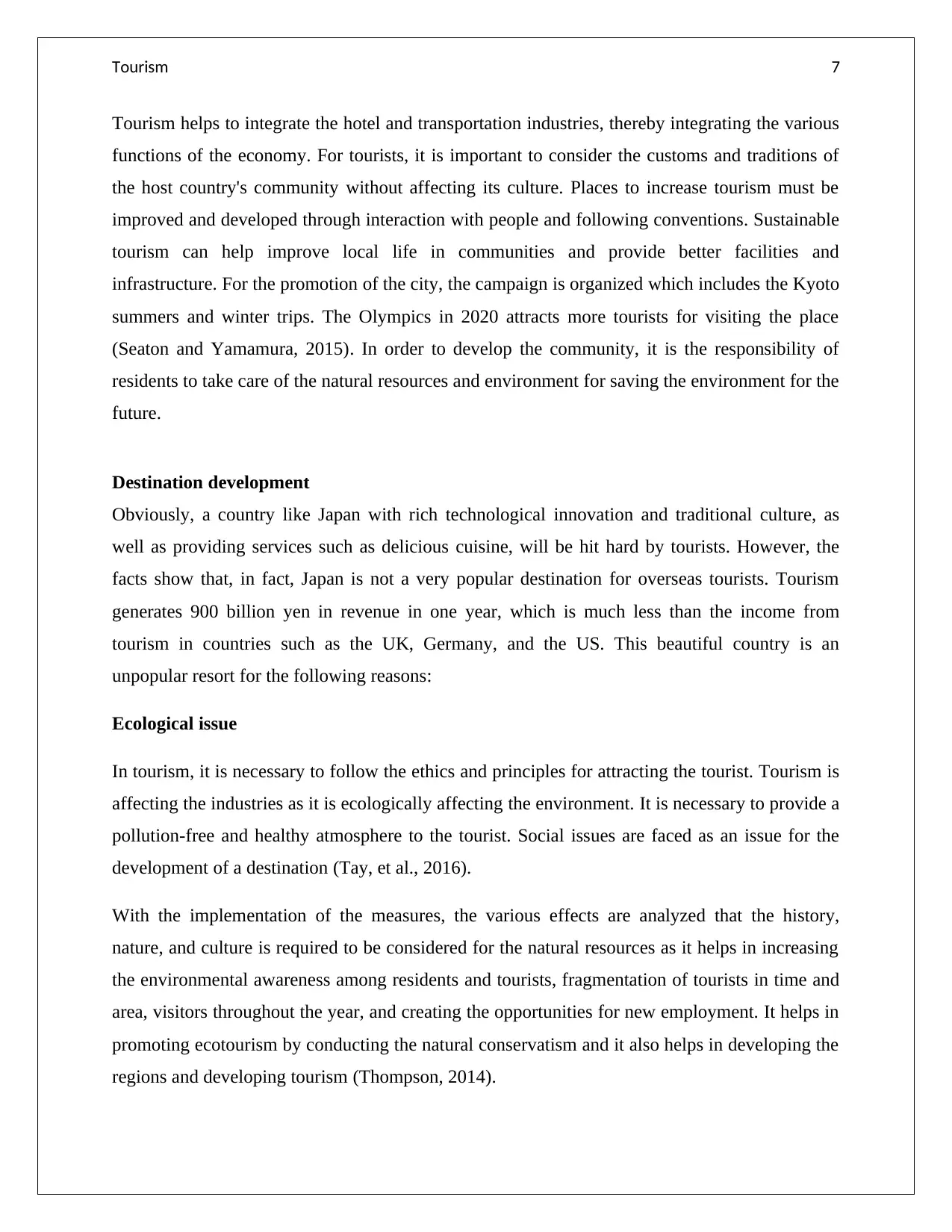
Tourism 7
Tourism helps to integrate the hotel and transportation industries, thereby integrating the various
functions of the economy. For tourists, it is important to consider the customs and traditions of
the host country's community without affecting its culture. Places to increase tourism must be
improved and developed through interaction with people and following conventions. Sustainable
tourism can help improve local life in communities and provide better facilities and
infrastructure. For the promotion of the city, the campaign is organized which includes the Kyoto
summers and winter trips. The Olympics in 2020 attracts more tourists for visiting the place
(Seaton and Yamamura, 2015). In order to develop the community, it is the responsibility of
residents to take care of the natural resources and environment for saving the environment for the
future.
Destination development
Obviously, a country like Japan with rich technological innovation and traditional culture, as
well as providing services such as delicious cuisine, will be hit hard by tourists. However, the
facts show that, in fact, Japan is not a very popular destination for overseas tourists. Tourism
generates 900 billion yen in revenue in one year, which is much less than the income from
tourism in countries such as the UK, Germany, and the US. This beautiful country is an
unpopular resort for the following reasons:
Ecological issue
In tourism, it is necessary to follow the ethics and principles for attracting the tourist. Tourism is
affecting the industries as it is ecologically affecting the environment. It is necessary to provide a
pollution-free and healthy atmosphere to the tourist. Social issues are faced as an issue for the
development of a destination (Tay, et al., 2016).
With the implementation of the measures, the various effects are analyzed that the history,
nature, and culture is required to be considered for the natural resources as it helps in increasing
the environmental awareness among residents and tourists, fragmentation of tourists in time and
area, visitors throughout the year, and creating the opportunities for new employment. It helps in
promoting ecotourism by conducting the natural conservatism and it also helps in developing the
regions and developing tourism (Thompson, 2014).
Tourism helps to integrate the hotel and transportation industries, thereby integrating the various
functions of the economy. For tourists, it is important to consider the customs and traditions of
the host country's community without affecting its culture. Places to increase tourism must be
improved and developed through interaction with people and following conventions. Sustainable
tourism can help improve local life in communities and provide better facilities and
infrastructure. For the promotion of the city, the campaign is organized which includes the Kyoto
summers and winter trips. The Olympics in 2020 attracts more tourists for visiting the place
(Seaton and Yamamura, 2015). In order to develop the community, it is the responsibility of
residents to take care of the natural resources and environment for saving the environment for the
future.
Destination development
Obviously, a country like Japan with rich technological innovation and traditional culture, as
well as providing services such as delicious cuisine, will be hit hard by tourists. However, the
facts show that, in fact, Japan is not a very popular destination for overseas tourists. Tourism
generates 900 billion yen in revenue in one year, which is much less than the income from
tourism in countries such as the UK, Germany, and the US. This beautiful country is an
unpopular resort for the following reasons:
Ecological issue
In tourism, it is necessary to follow the ethics and principles for attracting the tourist. Tourism is
affecting the industries as it is ecologically affecting the environment. It is necessary to provide a
pollution-free and healthy atmosphere to the tourist. Social issues are faced as an issue for the
development of a destination (Tay, et al., 2016).
With the implementation of the measures, the various effects are analyzed that the history,
nature, and culture is required to be considered for the natural resources as it helps in increasing
the environmental awareness among residents and tourists, fragmentation of tourists in time and
area, visitors throughout the year, and creating the opportunities for new employment. It helps in
promoting ecotourism by conducting the natural conservatism and it also helps in developing the
regions and developing tourism (Thompson, 2014).
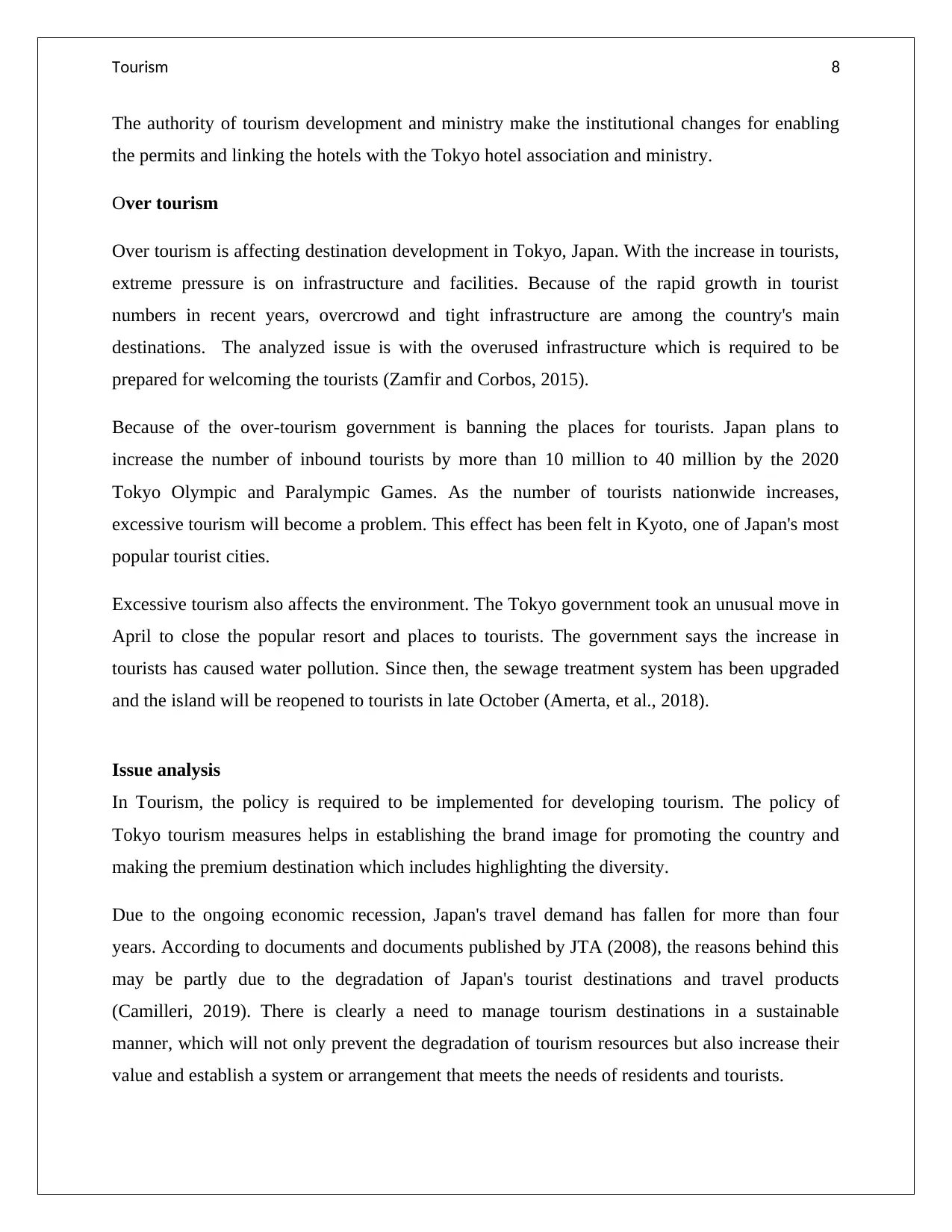
Tourism 8
The authority of tourism development and ministry make the institutional changes for enabling
the permits and linking the hotels with the Tokyo hotel association and ministry.
Over tourism
Over tourism is affecting destination development in Tokyo, Japan. With the increase in tourists,
extreme pressure is on infrastructure and facilities. Because of the rapid growth in tourist
numbers in recent years, overcrowd and tight infrastructure are among the country's main
destinations. The analyzed issue is with the overused infrastructure which is required to be
prepared for welcoming the tourists (Zamfir and Corbos, 2015).
Because of the over-tourism government is banning the places for tourists. Japan plans to
increase the number of inbound tourists by more than 10 million to 40 million by the 2020
Tokyo Olympic and Paralympic Games. As the number of tourists nationwide increases,
excessive tourism will become a problem. This effect has been felt in Kyoto, one of Japan's most
popular tourist cities.
Excessive tourism also affects the environment. The Tokyo government took an unusual move in
April to close the popular resort and places to tourists. The government says the increase in
tourists has caused water pollution. Since then, the sewage treatment system has been upgraded
and the island will be reopened to tourists in late October (Amerta, et al., 2018).
Issue analysis
In Tourism, the policy is required to be implemented for developing tourism. The policy of
Tokyo tourism measures helps in establishing the brand image for promoting the country and
making the premium destination which includes highlighting the diversity.
Due to the ongoing economic recession, Japan's travel demand has fallen for more than four
years. According to documents and documents published by JTA (2008), the reasons behind this
may be partly due to the degradation of Japan's tourist destinations and travel products
(Camilleri, 2019). There is clearly a need to manage tourism destinations in a sustainable
manner, which will not only prevent the degradation of tourism resources but also increase their
value and establish a system or arrangement that meets the needs of residents and tourists.
The authority of tourism development and ministry make the institutional changes for enabling
the permits and linking the hotels with the Tokyo hotel association and ministry.
Over tourism
Over tourism is affecting destination development in Tokyo, Japan. With the increase in tourists,
extreme pressure is on infrastructure and facilities. Because of the rapid growth in tourist
numbers in recent years, overcrowd and tight infrastructure are among the country's main
destinations. The analyzed issue is with the overused infrastructure which is required to be
prepared for welcoming the tourists (Zamfir and Corbos, 2015).
Because of the over-tourism government is banning the places for tourists. Japan plans to
increase the number of inbound tourists by more than 10 million to 40 million by the 2020
Tokyo Olympic and Paralympic Games. As the number of tourists nationwide increases,
excessive tourism will become a problem. This effect has been felt in Kyoto, one of Japan's most
popular tourist cities.
Excessive tourism also affects the environment. The Tokyo government took an unusual move in
April to close the popular resort and places to tourists. The government says the increase in
tourists has caused water pollution. Since then, the sewage treatment system has been upgraded
and the island will be reopened to tourists in late October (Amerta, et al., 2018).
Issue analysis
In Tourism, the policy is required to be implemented for developing tourism. The policy of
Tokyo tourism measures helps in establishing the brand image for promoting the country and
making the premium destination which includes highlighting the diversity.
Due to the ongoing economic recession, Japan's travel demand has fallen for more than four
years. According to documents and documents published by JTA (2008), the reasons behind this
may be partly due to the degradation of Japan's tourist destinations and travel products
(Camilleri, 2019). There is clearly a need to manage tourism destinations in a sustainable
manner, which will not only prevent the degradation of tourism resources but also increase their
value and establish a system or arrangement that meets the needs of residents and tourists.
⊘ This is a preview!⊘
Do you want full access?
Subscribe today to unlock all pages.

Trusted by 1+ million students worldwide
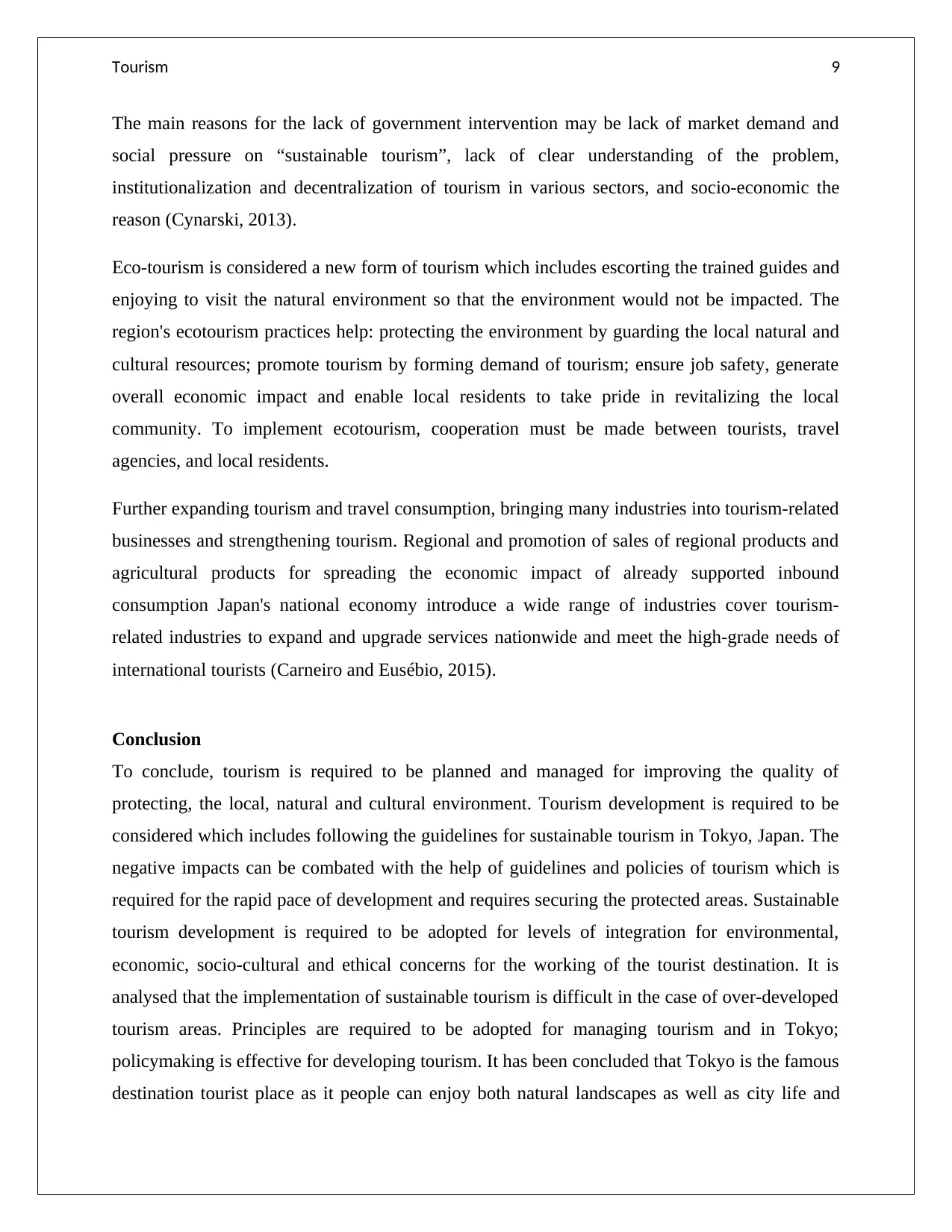
Tourism 9
The main reasons for the lack of government intervention may be lack of market demand and
social pressure on “sustainable tourism”, lack of clear understanding of the problem,
institutionalization and decentralization of tourism in various sectors, and socio-economic the
reason (Cynarski, 2013).
Eco-tourism is considered a new form of tourism which includes escorting the trained guides and
enjoying to visit the natural environment so that the environment would not be impacted. The
region's ecotourism practices help: protecting the environment by guarding the local natural and
cultural resources; promote tourism by forming demand of tourism; ensure job safety, generate
overall economic impact and enable local residents to take pride in revitalizing the local
community. To implement ecotourism, cooperation must be made between tourists, travel
agencies, and local residents.
Further expanding tourism and travel consumption, bringing many industries into tourism-related
businesses and strengthening tourism. Regional and promotion of sales of regional products and
agricultural products for spreading the economic impact of already supported inbound
consumption Japan's national economy introduce a wide range of industries cover tourism-
related industries to expand and upgrade services nationwide and meet the high-grade needs of
international tourists (Carneiro and Eusébio, 2015).
Conclusion
To conclude, tourism is required to be planned and managed for improving the quality of
protecting, the local, natural and cultural environment. Tourism development is required to be
considered which includes following the guidelines for sustainable tourism in Tokyo, Japan. The
negative impacts can be combated with the help of guidelines and policies of tourism which is
required for the rapid pace of development and requires securing the protected areas. Sustainable
tourism development is required to be adopted for levels of integration for environmental,
economic, socio-cultural and ethical concerns for the working of the tourist destination. It is
analysed that the implementation of sustainable tourism is difficult in the case of over-developed
tourism areas. Principles are required to be adopted for managing tourism and in Tokyo;
policymaking is effective for developing tourism. It has been concluded that Tokyo is the famous
destination tourist place as it people can enjoy both natural landscapes as well as city life and
The main reasons for the lack of government intervention may be lack of market demand and
social pressure on “sustainable tourism”, lack of clear understanding of the problem,
institutionalization and decentralization of tourism in various sectors, and socio-economic the
reason (Cynarski, 2013).
Eco-tourism is considered a new form of tourism which includes escorting the trained guides and
enjoying to visit the natural environment so that the environment would not be impacted. The
region's ecotourism practices help: protecting the environment by guarding the local natural and
cultural resources; promote tourism by forming demand of tourism; ensure job safety, generate
overall economic impact and enable local residents to take pride in revitalizing the local
community. To implement ecotourism, cooperation must be made between tourists, travel
agencies, and local residents.
Further expanding tourism and travel consumption, bringing many industries into tourism-related
businesses and strengthening tourism. Regional and promotion of sales of regional products and
agricultural products for spreading the economic impact of already supported inbound
consumption Japan's national economy introduce a wide range of industries cover tourism-
related industries to expand and upgrade services nationwide and meet the high-grade needs of
international tourists (Carneiro and Eusébio, 2015).
Conclusion
To conclude, tourism is required to be planned and managed for improving the quality of
protecting, the local, natural and cultural environment. Tourism development is required to be
considered which includes following the guidelines for sustainable tourism in Tokyo, Japan. The
negative impacts can be combated with the help of guidelines and policies of tourism which is
required for the rapid pace of development and requires securing the protected areas. Sustainable
tourism development is required to be adopted for levels of integration for environmental,
economic, socio-cultural and ethical concerns for the working of the tourist destination. It is
analysed that the implementation of sustainable tourism is difficult in the case of over-developed
tourism areas. Principles are required to be adopted for managing tourism and in Tokyo;
policymaking is effective for developing tourism. It has been concluded that Tokyo is the famous
destination tourist place as it people can enjoy both natural landscapes as well as city life and
Paraphrase This Document
Need a fresh take? Get an instant paraphrase of this document with our AI Paraphraser

Tourism 10
also have the largest metropolitan in the world. The negative and positive impact has been
analysed from the activity of tourists on the host community and key issues have also been
addressed in this report.
also have the largest metropolitan in the world. The negative and positive impact has been
analysed from the activity of tourists on the host community and key issues have also been
addressed in this report.
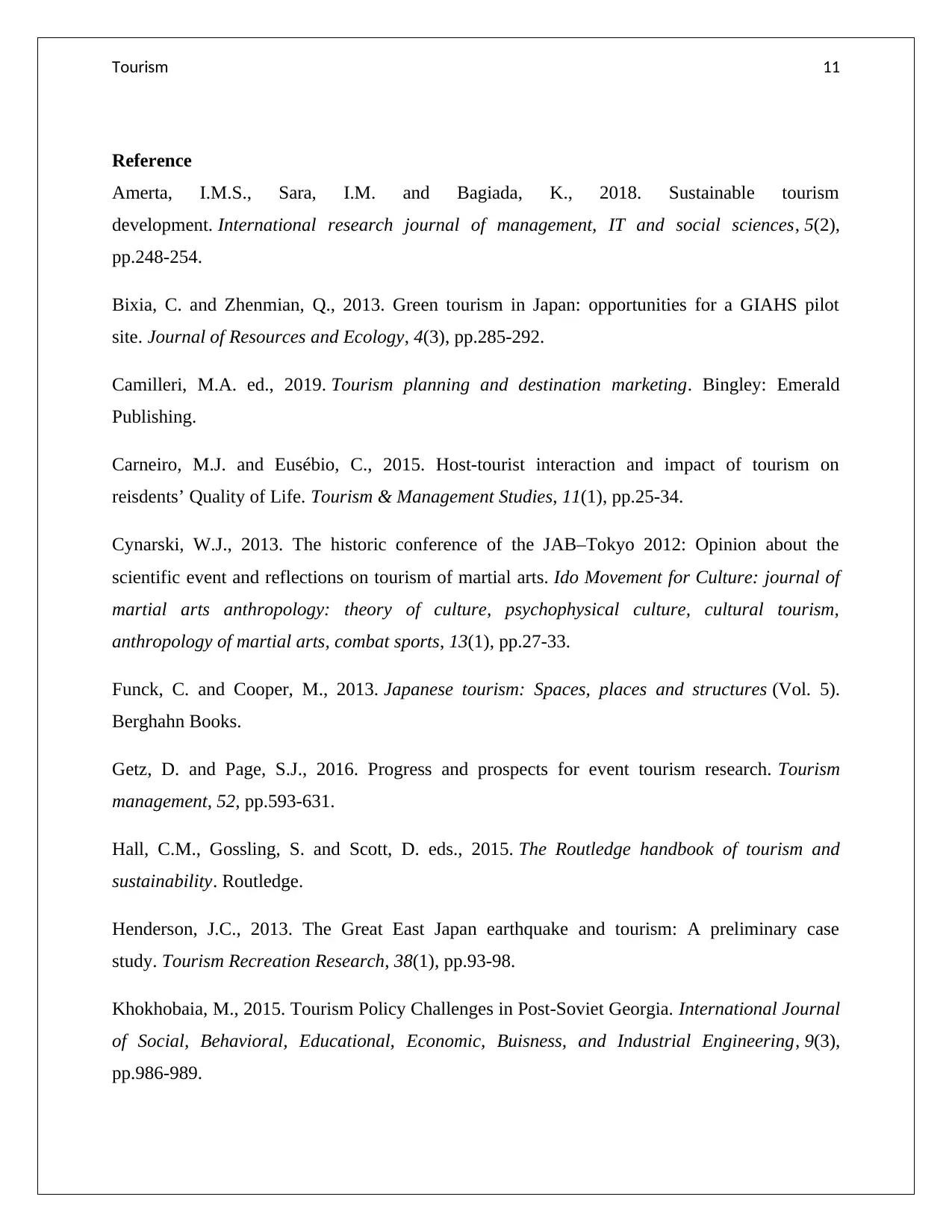
Tourism 11
Reference
Amerta, I.M.S., Sara, I.M. and Bagiada, K., 2018. Sustainable tourism
development. International research journal of management, IT and social sciences, 5(2),
pp.248-254.
Bixia, C. and Zhenmian, Q., 2013. Green tourism in Japan: opportunities for a GIAHS pilot
site. Journal of Resources and Ecology, 4(3), pp.285-292.
Camilleri, M.A. ed., 2019. Tourism planning and destination marketing. Bingley: Emerald
Publishing.
Carneiro, M.J. and Eusébio, C., 2015. Host-tourist interaction and impact of tourism on
reisdents’ Quality of Life. Tourism & Management Studies, 11(1), pp.25-34.
Cynarski, W.J., 2013. The historic conference of the JAB–Tokyo 2012: Opinion about the
scientific event and reflections on tourism of martial arts. Ido Movement for Culture: journal of
martial arts anthropology: theory of culture, psychophysical culture, cultural tourism,
anthropology of martial arts, combat sports, 13(1), pp.27-33.
Funck, C. and Cooper, M., 2013. Japanese tourism: Spaces, places and structures (Vol. 5).
Berghahn Books.
Getz, D. and Page, S.J., 2016. Progress and prospects for event tourism research. Tourism
management, 52, pp.593-631.
Hall, C.M., Gossling, S. and Scott, D. eds., 2015. The Routledge handbook of tourism and
sustainability. Routledge.
Henderson, J.C., 2013. The Great East Japan earthquake and tourism: A preliminary case
study. Tourism Recreation Research, 38(1), pp.93-98.
Khokhobaia, M., 2015. Tourism Policy Challenges in Post-Soviet Georgia. International Journal
of Social, Behavioral, Educational, Economic, Buisness, and Industrial Engineering, 9(3),
pp.986-989.
Reference
Amerta, I.M.S., Sara, I.M. and Bagiada, K., 2018. Sustainable tourism
development. International research journal of management, IT and social sciences, 5(2),
pp.248-254.
Bixia, C. and Zhenmian, Q., 2013. Green tourism in Japan: opportunities for a GIAHS pilot
site. Journal of Resources and Ecology, 4(3), pp.285-292.
Camilleri, M.A. ed., 2019. Tourism planning and destination marketing. Bingley: Emerald
Publishing.
Carneiro, M.J. and Eusébio, C., 2015. Host-tourist interaction and impact of tourism on
reisdents’ Quality of Life. Tourism & Management Studies, 11(1), pp.25-34.
Cynarski, W.J., 2013. The historic conference of the JAB–Tokyo 2012: Opinion about the
scientific event and reflections on tourism of martial arts. Ido Movement for Culture: journal of
martial arts anthropology: theory of culture, psychophysical culture, cultural tourism,
anthropology of martial arts, combat sports, 13(1), pp.27-33.
Funck, C. and Cooper, M., 2013. Japanese tourism: Spaces, places and structures (Vol. 5).
Berghahn Books.
Getz, D. and Page, S.J., 2016. Progress and prospects for event tourism research. Tourism
management, 52, pp.593-631.
Hall, C.M., Gossling, S. and Scott, D. eds., 2015. The Routledge handbook of tourism and
sustainability. Routledge.
Henderson, J.C., 2013. The Great East Japan earthquake and tourism: A preliminary case
study. Tourism Recreation Research, 38(1), pp.93-98.
Khokhobaia, M., 2015. Tourism Policy Challenges in Post-Soviet Georgia. International Journal
of Social, Behavioral, Educational, Economic, Buisness, and Industrial Engineering, 9(3),
pp.986-989.
⊘ This is a preview!⊘
Do you want full access?
Subscribe today to unlock all pages.

Trusted by 1+ million students worldwide
1 out of 13
Related Documents
Your All-in-One AI-Powered Toolkit for Academic Success.
+13062052269
info@desklib.com
Available 24*7 on WhatsApp / Email
![[object Object]](/_next/static/media/star-bottom.7253800d.svg)
Unlock your academic potential
Copyright © 2020–2025 A2Z Services. All Rights Reserved. Developed and managed by ZUCOL.





